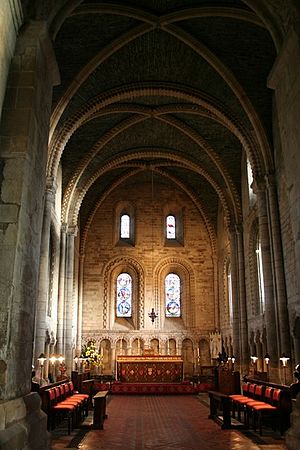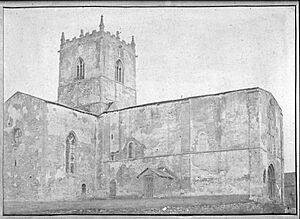Stow Minster facts for kids
Quick facts for kids Stow Minster |
|
|---|---|
| Minster Church of St Mary, Stow in Lindsey | |

Stow Minster
|
|
| Lua error in Module:Location_map at line 420: attempt to index field 'wikibase' (a nil value). | |
| Denomination | Church of England |
| Previous denomination | Roman Catholic |
| Architecture | |
| Functional status | Active |
| Heritage designation | Grade I listed building |
| Administration | |
| Parish | Stow in Lindsey |
| Deanery | Deanery of Corringham |
| Diocese | Diocese of Lincoln |
The Minster Church of St Mary, Stow in Lindsey is a very old and important church in Lincolnshire, England. It is one of the biggest and oldest parish churches in the country. Some people believe it was once the main church, or "cathedral," for the area of Lindsey way back in the 600s. Because of its long history, it's often called the "Mother Church of Lincolnshire."
This church is special because it has parts built in both the Anglo-Saxon and Norman times. It's considered a Grade I listed building by English Heritage, which means it's a very important historical site. In 2006, the World Monuments Fund even put it on a list of the world's 100 most endangered places, showing how much it needs protection.
Stow Minster has some amazing features. It has the tallest Anglo-Saxon arches from its time in Britain. You can also find the earliest known example of Viking graffiti in England there – a drawing of a Viking ship, probably from the 900s! There's an old font (a basin for baptisms) with nine supports and ancient symbols, plus an early wall painting dedicated to Thomas Becket.
Today, Stow Minster is part of a group of churches in the Stow area.
History of Stow Minster
For a long time, people have wondered exactly where the main church seat, or "cathedra," for the ancient area of Sidnacester was located. Many thought it was in places like Caistor, Louth, Horncastle, or most often, Stow. However, its exact spot is still a mystery. More recently, Lincoln has also been suggested as a possible location.
There was a church in Stow even before the Danes arrived in 870. Sadly, the Danes burned that church down. The building stayed in ruins for many years until a new abbey was built there around 1040. It is believed that Bishop Eadnoth II was responsible for this.
Some historical records suggest that a bishop named Alfnoth built a church in Stow around 975. He might have built it on the site of an even older wooden Anglo-Saxon church. This church was meant to be a "minster," or a main church, for the Lincolnshire part of his large area. It was like a second cathedral because some of the bishop's priests lived in Stow and helped manage that part of the area. This is why people remember Stow as the "Mother Church" of Lincoln Cathedral.
It is also said that the church was rebuilt and given new support in 1054 by Leofric and Godiva, with encouragement from Wulfwig. In 1091, another bishop, Remigius of Fécamp, turned it into a Benedictine abbey called Stow Abbey. He brought monks from Eynsham Abbey to live there, describing the church as having been empty and ruined for a long time. However, within five years, the next bishop sent the monks back to Eynsham, and St Mary's became a regular parish church again.
In 1865, a famous architect named John Loughborough Pearson added a stair tower outside the church. This staircase used to be inside the church. At the same time, some windows were changed, and the church got a new roof. A new room for the clergy, called a vestry, was added in the early 1990s. During this work, some old skeletons and a broken stone cross from the 1200s were discovered.
About a mile west of the village, near an old Roman road called Tillbridge Lane, you can find the remains of a medieval palace. This palace belonged to the bishops of Lincoln and was built in 1336. Today, you can only see the earthworks of its moat (a ditch filled with water) and the remains of old fish-ponds that were part of the palace grounds.
Protecting Stow Minster
Stow Minster is a Grade I listed building, which means it's very important historically. In 2006, the World Monuments Fund included it in its list of the 100 most endangered sites in the world. This shows how much care and effort are needed to protect it. The church building itself is also a scheduled monument, which gives it special legal protection.
The first step in protecting the church is to make sure it's weatherproof. This means fixing the roof and walls so that rain and wind can't get inside. Only after this is done can work begin on the inside of the church. Experts believe that all the necessary repairs and conservation work will take at least 10 years to finish and could cost between £2 million and £3 million.
See also
- List of ecclesiastical restorations and alterations by J. L. Pearson



